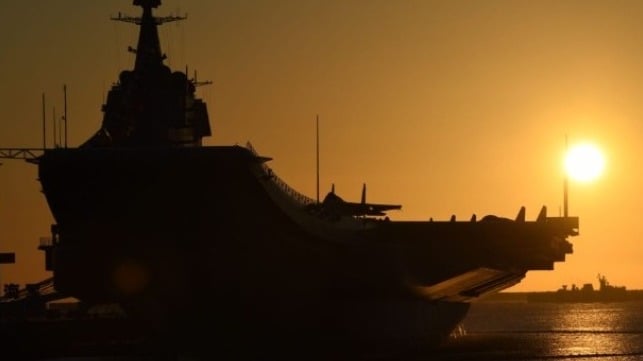China Tests Trump's Resolve on Taiwan
Beijing is seeking to normalize pressure on Taipei and test out how transactional the United States has become.

[By Sophie Wushuang Yi]
China’s People’s Liberation Army last week deployed the aircraft carrier Shandong alongside 19 warships in military exercises encircling Taiwan. Initially conducted without an official codename – a departure from previous practice – these drills were later designated “Strait Thunder-2025A”, along with a signal of potential follow-up operations later this year.
These exercises occurred against a backdrop of deteriorating cross-Strait relations. Taiwan’s Lai Ching-te last month labelled China a “foreign hostile force” and announced plans to re-establish Taiwan’s peacetime military court system, marking a significant rhetorical escalation. The PLA exercises featured live-fire drills, simulated blockade operations, and unprecedented aerial incursions, occurring around the anniversary of the 1979 Taiwan Relations Act, a key US policy milestone.
The core of the issue is an unfinished civil war. China has consistently asserted that Taiwan is an integral part of its territory and views such military exercises as measures to safeguard its sovereignty and territorial integrity.
What distinguishes this moment is the deliberate shift in presentation. Previously, major exercises including “Joint Sword” in 2023 were explicitly framed as exceptional responses to specific provocations. The eventual codename “Strait Thunder-2025A” given to the latest exercises suggests a transition from episodic responses to a more systematic approach to military pressure.
Particularly revealing was the release by the PLA Eastern Theatre Command of four military action posters, representing a comprehensive coercion strategy of “advancing”, “deterrence-containment”, “destruction-paralysis” and “lock-control”. The effort was psychological intimidation through show of force and the suggestion of encirclement.
This approach serves three objectives. First, it normalises substantial military activities in contested waters, gradually reshaping international expectations. Zhang Chi of China’s National Defence University confirmed this strategy, stating the unnamed approach has become “normal practice”. Such framing indicates Beijing’s intention to normalise its military activities around Taiwan.
Second, it allows China to incrementally increase pressure without triggering crisis-level responses that specially named operations might provoke. Chinese state television explained that the initial activities were deliberately not labelled as part of “Strait Thunder-2025A” to demonstrate the armed forces’ ability to adapt to rapidly evolving combat situations.
Third, it supports a sovereignty narrative by characterising exercises as routine domestic security operations.
The comparison to the 1995-1996 Taiwan Strait Crisis is instructive. Those exercises, codenamed “Strait 961” and involving missile tests near Taiwan’s ports, were explicitly identified as extraordinary events. The current approach represents an important evolution – no longer framing military pressure as exceptional but as the ordinary state of affairs.
Particularly significant was the integration of simulated “inspection and capture” operations against vessels – blending aspects of maritime interdiction with conventional military operations in a way that suggests preparation for enforcing territorial claims through military means. According to the PLA’s Eastern Theatre Command, the exercises focused on “identification and verification, warning and expulsion, and interception and detention” while testing troop capabilities in area control, joint blockade operations, and precision strikes on key targets.
Unlike previous themes emphasising “sword” imagery that connotes direct military action, the new strategic themes suggest a more comprehensive approach to control – combining psychological pressure with physical constraint through a systematic progression of military actions.
These military exercises reflect China’s enduring strategic commitment to national reunification rather than short-term tactical calculations. Notably, the prominent deployment of coast guard vessels for “law enforcement patrols” surrounding Taiwan represents a calculated strategic manoeuvre. This approach strategically signals Beijing’s assertion of these waters as “internal seas” under domestic Chinese jurisdiction, effectively militarising civilian maritime agencies in support of territorial claims.
China’s military activities beyond the first island chain have increased substantially since 2023, with notable growth in both naval deployments and aerial operations throughout the Western Pacific. This marked escalation reflects a significant evolution in Beijing's approach to regional power projection, moving from occasional demonstrations to persistent maritime presence.
All this coincides with the return of Donald Trump to the White House, where his reputation for a transactional foreign policy – emphasising bilateral deals and cost-benefit calculations over traditional alliance structures – potentially complicates America’s longstanding strategic ambiguity regarding Taiwan. His administration’s focus on reducing foreign military commitments while pushing allies to increase defence spending creates a space that Beijing appears eager to test.
These exercises may represent a calculated probe by China of Trump’s intentions. The nomenclature adopted to describe the exercises, along with the scale, might be a test for an administration emphasising deal-making over ideological confrontation.
Sophie Wushuang Yi is a Postdoctoral Teaching Fellow at Schwarzman College, Tsinghua University, specialising in international relations, military and strategic studies, and China’s foreign policy. She earned her PhD in Chinese Studies Research from King’s College London, where she explored military transparency and strategic dynamics in US-China relations.
This article appears courtesy of The Lowy Interpreter and may be found in its original form here.
The opinions expressed herein are the author's and not necessarily those of The Maritime Executive.
